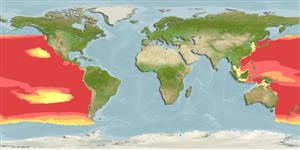Common names from other countries
>
Myctophiformes (Lanternfishes) >
Myctophidae (Lanternfishes) > Lampanyctinae
Etymology: Lampadena: Greek, lampas, -ados = torch + Greek, aden = gland (Ref. 45335).
Issue
Issue on validity of subspecies: subspecies considered as valid in FB, elevated to species rank as Lampadena urophaos Paxton, 1963 in Eschmeyer (CofF ver. Mar. 2011: Ref. 86697). Please send references, or more studies are needed.
Environment: milieu / climate zone / depth range / distribution range
Οικολογία
Θαλασσινό(ά); εύρος βάθους 50 - 1047 m (Ref. 58302). Subtropical; 48°N -
Western Pacific: Suruga Bay, Japan and near the Ogasawara and Ryukyu islands. Also New South Wales, Australia (Ref. 7300) and New Zealand (Ref. 5755). Eastern Pacific: between 42°N and 25°N from the California coast to Hawaii (Ref. 4479). Recorded off British Columbia, Canada (Ref. 11980) and from Chile (Ref. 9068).
Μέγεθος / Βάρος / Age
Maturity: Lm ? range ? - ? cm
Max length : 20.0 cm SL αρσενικό/απροσδιόριστο; (Ref. 123983)
Short description
Κλείδες προσδιορισμού | Μορφολογία | Μορφομετρία
Ραχιαίες άκανθες (συνολικά) : 0; Μαλακές ραχιαίες ακτίνες (συνολικά) : 14 - 16; Εδρικές άκανθες: 0; Μαλακές εδρικές ακτίνες: 13 - 14; Σπόνδυλοι: 35 - 38. Branchiostegal rays: 9-10 (Ref. 31442).
Epipelagic to mesopelagic (Ref. 31442) at 50-600 m at night, 500-1000 m during day (Ref. 58302). Reported from depths of 100-500 m in Subarctic Pacific gyres (Ref. 51600). Oviparous, with planktonic eggs and larvae (Ref. 31442).
Life cycle and mating behavior
Maturities | Αναπαραγωγή | Spawnings | Egg(s) | Fecundities | Προνύμφες
Paxton, J.R., D.F. Hoese, G.R. Allen and J.E. Hanley, 1989. Pisces. Petromyzontidae to Carangidae. Zoological Catalogue of Australia, Vol. 7. Australian Government Publishing Service, Canberra, 665 p. (Ref. 7300)
IUCN Red List Status (Ref. 130435)
CITES (Ref. 128078)
Not Evaluated
Threat to humans
Harmless
Human uses
Εργαλεία
Special reports
Download XML
Διαδικτυακές πηγές
Estimates based on models
Preferred temperature (Ref.
115969): 3.1 - 19.2, mean 12 (based on 460 cells).
Phylogenetic diversity index (Ref.
82804): PD
50 = 0.5010 [Uniqueness, from 0.5 = low to 2.0 = high].
Bayesian length-weight: a=0.01023 (0.00413 - 0.02535), b=3.06 (2.85 - 3.27), in cm Total Length, based on LWR estimates for this (Sub)family-body shape (Ref.
93245).
Τροφικό Επίπεδο (Ref.
69278): 3.2 ±0.2 se; based on size and trophs of closest relatives
Ελαστικότητα (Ref.
120179): Μεσαίο(α), ελάχιστος χρόνος για διπλασιασμό πληθυσμού 1,4 - 4,4 έτη (Preliminary K or Fecundity.).
Fishing Vulnerability (Ref.
59153): Low vulnerability (14 of 100).
